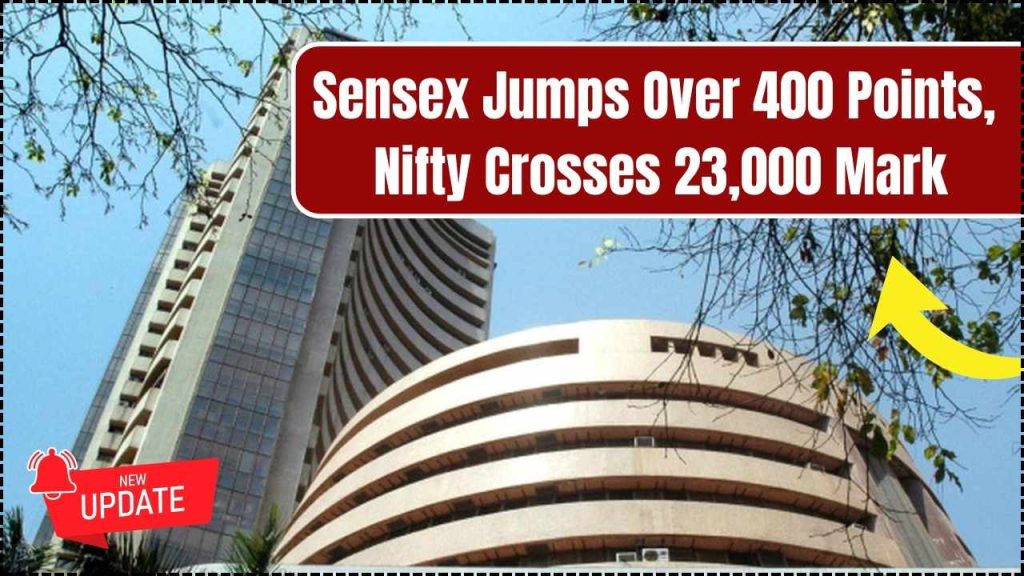
Sensex Jumps Over 400 Points: The Indian stock markets soared on January 28, 2025, with the BSE Sensex surging over 700 points to close at 76,069.97, while the Nifty 50 index climbed an impressive 169 points, crossing the 23,000 mark to settle at 23,000.85. This robust rally was fueled by a mix of policy announcements, strong sectoral performances, and a surge in investor confidence, highlighting the resilience of India’s economy amidst global uncertainties.
India’s stock markets, often characterized by their volatility, overcame significant global and domestic challenges to post these gains, marking a major turning point for investors. Below, we provide an in-depth analysis of the key drivers, sectoral highlights, and insights on what this rally means for the market’s future trajectory.
Sensex Jumps Over 400 Points
| Key Metrics | Details |
|---|---|
| Sensex Closing Value | 76,069.97 |
| Nifty Closing Value | 23,000.85 |
| Top Performers | Axis Bank, Infosys, Larsen & Toubro |
| RBI Policy Measures | Liquidity infusion through $5-billion USD/rupee swap and bond purchases |
| Sectoral Gainers | Banking, IT, Infrastructure |
The Indian stock markets showcased remarkable resilience and growth on January 28, 2025, with the Sensex and Nifty posting significant gains. This rally, driven by strategic policy measures and strong sectoral performances, underscores the strength and potential of the Indian economy. While opportunities abound, investors should stay informed and cautious to navigate potential risks effectively.
What Drove the Market Rally?
The market rally was influenced by several critical factors, ranging from proactive policy measures by the Reserve Bank of India (RBI) to strong performances across key sectors. Here’s a detailed breakdown of the driving forces:
1. Reserve Bank of India’s Liquidity Measures
The RBI played a pivotal role in stabilizing the markets by announcing significant liquidity measures. These included a ₹60,000-crore bond purchase program and a $5-billion USD/rupee buy-sell swap auction aimed at infusing durable liquidity into the financial system. By taking these steps, the central bank not only eased liquidity concerns but also boosted investor confidence in the broader financial system.
The direct impact of these measures was most evident in the banking sector, which saw a significant uptick as improved liquidity translated into better credit availability and lower borrowing costs.
2. Global Market Cues and Domestic Resilience
While global markets were rattled by uncertainties surrounding the rapid evolution of artificial intelligence and concerns over potential economic slowdowns, Indian markets demonstrated remarkable resilience. Analysts attributed this strength to the domestic economy’s consumption-driven nature and the RBI’s timely interventions, which helped counterbalance external pressures.
3. Sectoral Performances Boost Market Sentiment
Strong performances across major sectors added to the market’s upward momentum:
- Banking Sector: The BSE Bankex index surged over 900 points, reaching 55,592.57, driven by robust performances from Axis Bank, HDFC Bank, and ICICI Bank.
- IT Sector: IT stocks like Infosys and TCS saw gains on the back of strong quarterly earnings and continued demand for digital transformation solutions globally.
- Infrastructure: Infrastructure giant Larsen & Toubro (L&T) contributed significantly to the rally, buoyed by a high-value international order to construct Uzbekistan’s first AI-enabled data center.
Sectoral Analysis
Banking and Financials
The banking sector emerged as the biggest gainer in this rally, benefiting directly from the RBI’s liquidity measures and strong investor confidence. Improved credit growth and stable asset quality further solidified the sector’s position as a top performer.
- Key Gainers: Axis Bank, ICICI Bank, HDFC Bank
- Outlook: Analysts remain optimistic about the banking sector, predicting sustained growth due to favorable macroeconomic conditions and supportive monetary policies.
Information Technology
India’s IT sector continued its upward trajectory, driven by strong demand for technology services and solutions in areas like cloud computing, cybersecurity, and AI integration.
- Key Gainers: Infosys, TCS, Wipro
- Outlook: The sector’s growth is expected to persist, supported by digital transformation trends and increased spending by global clients.
Infrastructure
The infrastructure sector experienced significant gains, reflecting increased government focus on capital expenditure and large-scale international projects secured by Indian companies.
- Key Gainers: Larsen & Toubro, Adani Ports
- Outlook: The sector is poised for sustained growth, backed by public-private partnerships and rising global demand for infrastructure expertise.
Stock Picks: इन शेयरों में मिल सकता है 50% से ज्यादा का बंपर रिटर्न, देखें लिस्ट
Multibagger Stock: 1.8 लाख बन गए 984 करोड़, कैसे इस स्टॉक ने बना दिया करोड़पति, देखें
Market Sentiment and Investor Insights
The rally also highlighted a shift in market sentiment, with investors demonstrating renewed optimism in the face of global headwinds. Key drivers of this positive sentiment included:
- Proactive Policy Interventions: The RBI’s liquidity measures provided a strong foundation for market stability.
- Strong Corporate Earnings: Quarterly results from leading firms across banking, IT, and infrastructure underscored the resilience of the Indian economy.
- Domestic Consumption Growth: India’s robust domestic market acted as a buffer against external shocks, ensuring continued investor interest.
However, experts caution that investors should remain vigilant, as potential risks such as inflation, geopolitical tensions, and global economic uncertainties could still impact market dynamics.
FAQs On Sensex Jumps Over 400 Points
1. Why did the Sensex and Nifty rally on January 28, 2025?
The rally was driven by RBI liquidity measures, strong performances in banking, IT, and infrastructure sectors, and positive investor sentiment fueled by domestic economic resilience.
2. Which sectors contributed the most to the rally?
The banking, IT, and infrastructure sectors were the top contributors, reflecting strong earnings and favorable policy support.
3. How did the RBI’s measures impact the markets?
The RBI’s liquidity infusion through bond purchases and USD/rupee swaps boosted market confidence and improved credit availability, particularly benefiting the banking sector.
4. Should investors focus on banking stocks?
Banking stocks appear promising due to robust credit growth and supportive monetary policies, but investors should perform due diligence or consult financial advisors.
5. What risks should investors consider?
Investors should remain cautious about global uncertainties, including inflationary pressures, geopolitical tensions, and potential slowdowns in major economies.











